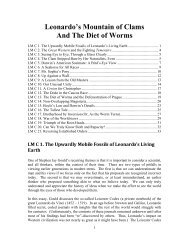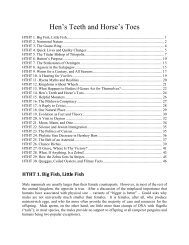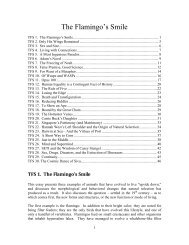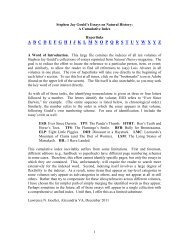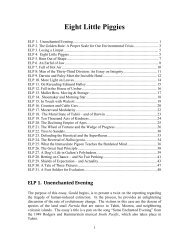interest, until the entrepreneur offers to support his research for a few years if he agrees.Done! Gould notes that paleontologists, and researchers in natural history in general,have always depended on sponsors of one sort or another for money. Of course, most ofthese sponsors have been motivated by forces other than simple interest in the field ofresearch. Museums suffer in a similar fashion, and depend to an ever larger extent on giftshops selling mostly useless stuff to pay the bills. Museum administrators build largemovie screens and bring in exotic but scientifically limited displays, he says, hoping thatpeople will walk by the “real” exhibits on the way. Gould expresses hope that the humanneed for authenticity – to see actual fossils, not replicas, or even animated models – willcontinue to draw people to museums.DIH 18. Cabinet Museums: Alive, Alive, Oh!The term “cabinet museum” refers to a Victorian-era style of exhibit hall that crams asmany specimens as possible into glass display cases, with wooden drawers below to holdyet more specimens. This contrasts with the modern approach of exhibiting only a fewkey objects, with notes and sometimes-interactive features to optimize the educationalaspect of the display. The Dublin Museum of Natural History, built in the 1850’s, is onesuch cabinet museum. Gould visited this facility in 1971, as part of a research project onIrish Elks [see ESD 9], and hated the place. It was dark and decaying, with a century ofgrime. He returned to this facility in 1993, and found it to have been beautifully restored.<strong>In</strong> its cleaned and refurbished condition, it suddenly became apparent to Gould what theattraction was – one could spend hours in front of a single cabinet, and many like-mindedpeople he knows of did in similar museums. He wrote this essay to congratulate the cityof Dublin for restoring not only the exhibits, but also the entire building to its 19 th -century splendor. Newer exhibits can be found in adjacent buildings, but this onebecomes a museum not only of the thousands of specimens, but also of a period in Britishhistory. Nearby is a statue of Molly Malone, a possibly-real 18 th -century seller of freshcockles and mussels. A song about her, which includes the line “Alive, alive, oh!” (inthe English translation, and referring to the freshness of the shellfish), is an unofficialanthem of Dublin.DIH 19. Evolution by WalkingThis essay celebrates the reopening of the fourth floor of one of Gould’s favoritechildhood and adult haunts, the American Museum of Natural History in New York. Thetwo great halls that exhibit fossil and extant mammals were completely reorganized aswell as refurbished. The organizing principle of the revised exhibits is the taxonomicmodel of cladistics, which focuses on the sequence of branching events in evolutionaryhistory. This organizational structure is very important for what it does not do:emphasize perceived increases in complexity or progress (inevitably toward humans).This removal of humans from the center of the universe and the inevitable apex of naturalhistory is a common theme in Gould’s writing [DIH 25]. He is delighted to see thispedagogical institution present this perspective in such a visceral way: by walking downthe main route through these halls, the visitor comes to primates – including humans – inthe middle, not at the end.24
The exhibit follows the six major branching events in mammalian history that cladisticsemphasizes. The first is the synapsid opening, a hole in the skull behind the eye thatseparates early mammals from other groups of reptiles. [It is important to recognize thatscientists use this feature simply as an identifier. It shows a common origin, but no claimis implied that this feature grants any particular evolutionary advantage or representsprogress. Other branches continue to evolve.] The second event is the formation of thedistinctive 3-boned mammalian ear. The third is the development of the placenta, whereour group branches off from the order that includes the platypus. The fourth is theformation of a hole in one of the bones in the middle ear; primates branch off at thispoint. Fifth is the formation of the hoof, which occurred after primates came intoexistence. Sixth is a distinctive movement of the eye sockets near the nose, a featurewhich is shared by elephants and manatees (sea cows). This puts sea cows at the end ofthe hall of mammals, which delights Gould. He does, however, offer a word of caution:new iconographies can free us from old biases, but can introduce new ones. He notes thatcladistics downplays unique traits formed by single lineages, such as the large teeth ofsaber-toothed tigers, and the bipedal gait of the genus Homo. It also downplays trendswithin groups that do not lead to further branchings, such as the reduction in the numberof toes in the natural history of horses, or larger brains in one group of primates. Suchevents are important, he argues, even if de-emphasized by cladistics.DIH 20. The Razumovsky DuetThe source of this essay is the dedication to an old book that Gould purchased. Thebook, written by Johann Gotthelf Fischer von Waldheim (1771 – 1853), was a minor butuseful reference work on zoological classification for Russian academics. GotthelfFischer was born in Saxony (now Germany), and was involved in the activity thatcoordinated the naming of geological strata. He may have coined the term“paleontology.” He spent the majority of his career in Moscow, as a professor andcurator of the natural history museum there. Importantly, he was there when Napoleonarrived, and during the subsequent fire that destroyed some two-thirds of the city. Thisfire prevented Napoleon from feeding his troops and thus forced his disastrous retreat;but it was also a disaster for the city, including the natural history museum, which wasdestroyed.This brings us to the dedication of Gotthelf Fischer’s book, published in 1813; it is a pleafor help (on behalf of his museum) to the Russian Minister of Public <strong>In</strong>struction. Thisminister’s name was Alexis Razumovsky; his brother, Gould discovered in his research,was Andrei Razumovsky. Andrei lived in Austria and was a great patron of the arts ingeneral, and to Beethoven in particular. (Beethoven dedicated several of his works to hispatron, including the famous “Razumovsky Quartets.”) Gotthelf Fischer was not assuccessful with Andrei’s brother Alexis, however. But over the next twenty or so years,Gotthelf Fischer did succeed in partially rebuilding the museum’s collection. His successcame not from wealthy patrons, but from his fellow scientists throughout Russia and therest of Europe, who donated, traded, or sold books and specimens. The thesis of this25
- Page 4 and 5: cloud (“nebula”) of gas and dus
- Page 6 and 7: goodness, and is both intelligent a
- Page 9: The second news story involves the
- Page 12 and 13: key ways. Prior to 1994, no fossil
- Page 14: DIH 11. Lucy on the Earth in Stasis
- Page 17: directly resulted in a mass extinct
- Page 20 and 21: Edgar Allan Poe, it turns out, wrot
- Page 22 and 23: things male, while the beautiful is
- Page 26 and 27: essay is that scientists, for all t
- Page 28 and 29: DIH 23. The Smoking Gun of Eugenics
- Page 30 and 31: half-Jewish meant Jewish, while qua
- Page 32 and 33: Darwin’s theory, like Adam Smith
- Page 34 and 35: What might a better definition of t
- Page 36 and 37: type of soil, amount of rain, and s
- Page 38 and 39: Case Four, in Gould’s words, is
- Page 40 and 41: multiplying his findings by the num
- Page 42 and 43: other departments, something that r
- Page 44 and 45: Linnaeus, Gould states, did not sim
- Page 46: greatly prefers these metaphors, on




